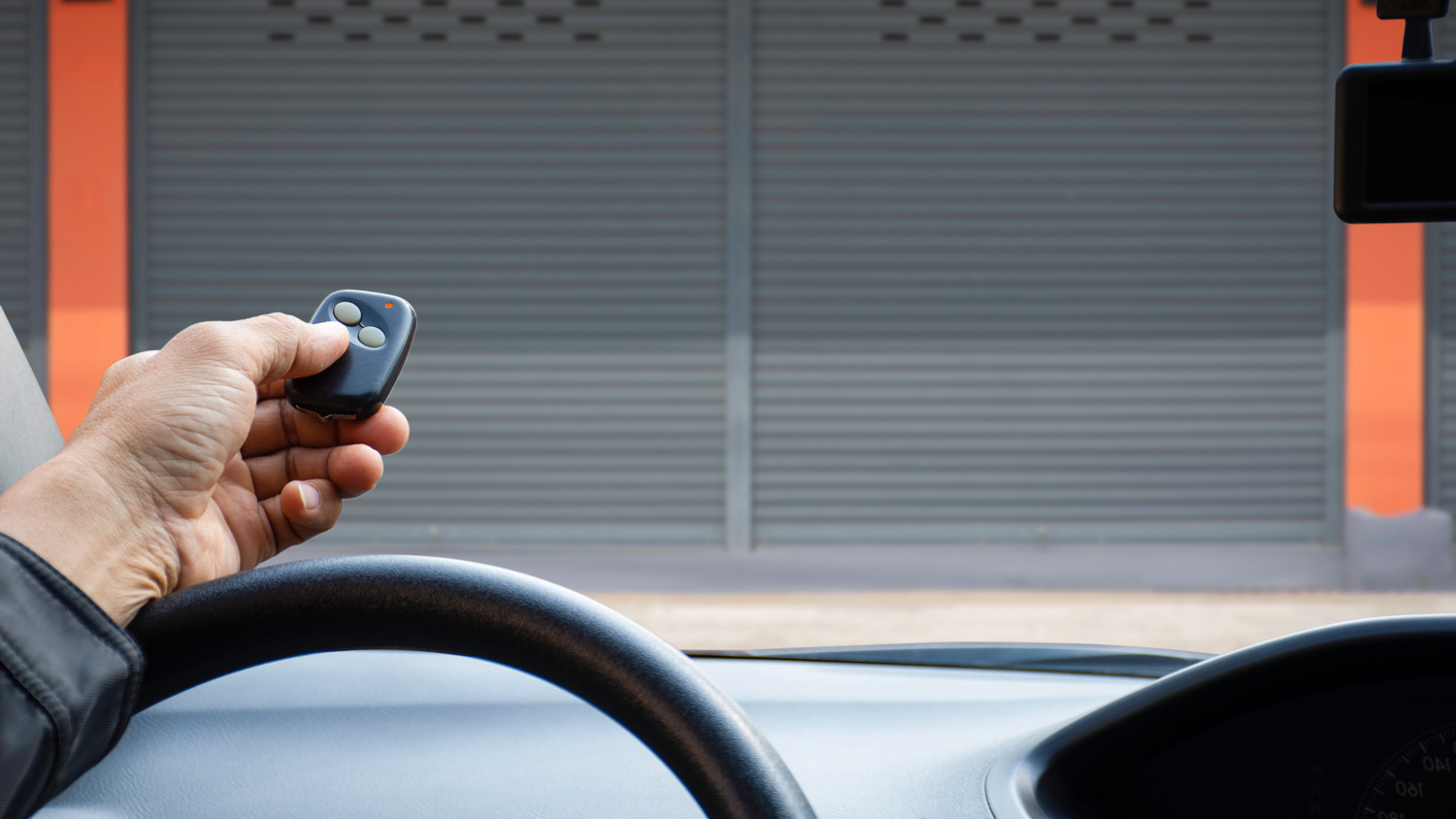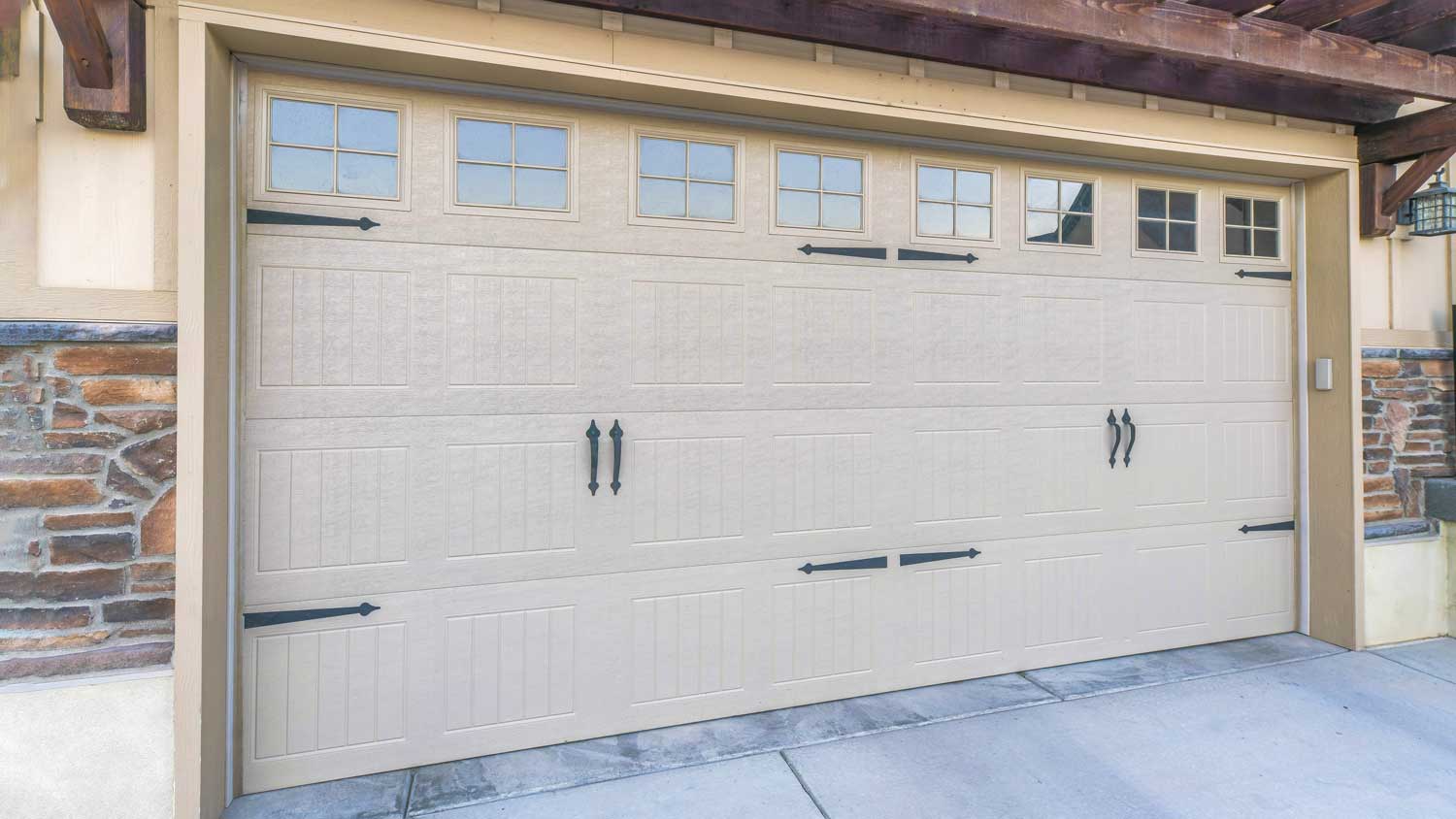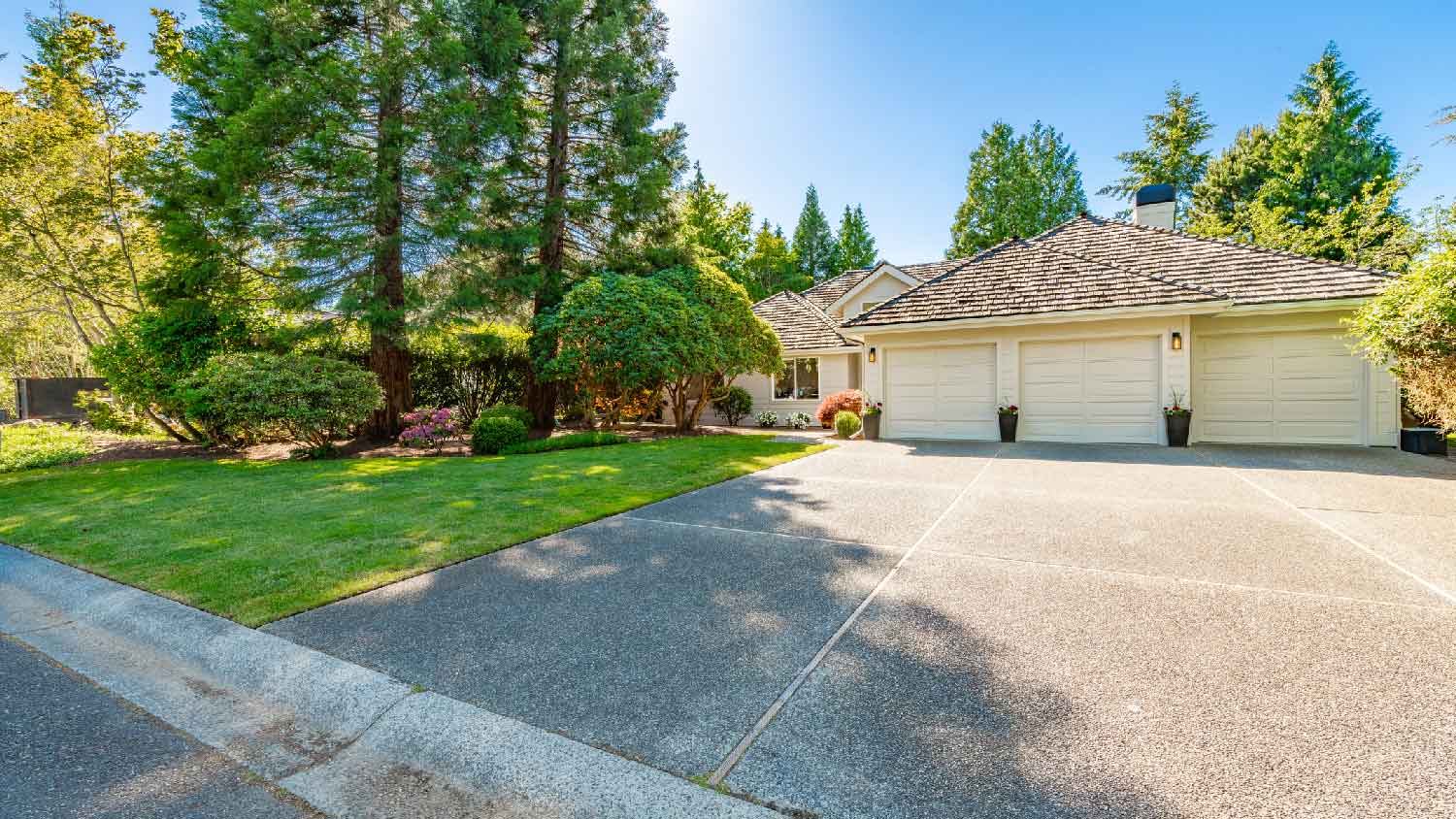10 Garage Door Maintenance Tips for Maximum Longevity
Keep your garage door in tip-top condition


Despite being the largest moving part of a home, the garage door is something we take for granted. That is, until it ceases to work. By that time, the garage door usually requires a costly repair to fix. By giving the garage door a little TLC every now and then, you can ensure it continues to work properly. This guide provides a complete rundown of how to maintain a garage door to keep it opening and closing smoothly.
1. Clean the Tracks
The garage door opens and closes with a series of wheels on both sides that glide up and down a metal track. When these tracks become clogged with dirt, sawdust, or rust, or other debris, they hinder that motion from happening, making it more difficult for the door to raise and lower smoothly. In some cases, you might even find that your garage door won’t close or open at all because of the build-up.
Spray the inside of the tracks with brake cleaner to break down any corrosion.
Use an old toothbrush to dislodge any grime or rust that’s built up on the side of the tracks.
Wipe the tracks down with an old rag to remove the grime and excess brake cleaner.
2. Lubricate Parts
Now that the garage door rails are free of debris and rust, it’s time to lubricate the garage door’s moving parts.
Apply a lubricant to the metal rollers and garage door tracks.
Lubricate the hinges that hold each of the garage door panels.
Spray penetrating oil onto the tension spring to remove any dirt or corrosion that may have formed on it.
3. Check the Door Balance
The torsion springs are responsible for providing the necessary power to raise and lower the door, which can weigh upwards of 200 pounds. In order for the torsion springs to work properly and allow your garage door to open and close safely, they must be properly balanced.
Start by disconnecting the garage door from the garage door opener.
With the garage door closed, pull the release cord that hangs down from the opener.
Lift the door about halfway up then let it go. If the door remains in place, it’s properly balanced. If it falls downward, the tension on the torsion spring needs to be adjusted. Torsion springs are under high tension and can cause serious injuries if not handled properly, so it’s best to leave this job to a professional garage door installer near you.
4. Test the Garage Door Opener’s Safety Features

Given that garage doors can weigh upwards of 200 pounds or more, they present a dangerous crushing hazard. As such, it’s absolutely essential that you test the garage door opener’s safety features. The garage door should either have laser sensors that sit at either end of the garage door about 4 to 6 inches off the ground or a pressure sensor.
If your garage door opener has a laser sensor, test it by pressing the garage door opener button to begin closing the door. Place an object, like a piece of plywood, in the path of the sensor. The door should instantly stop and reverse direction.
If your garage door has a pressure sensor, place a 2x4 flat side down under the door and close the door. The door should reverse within a second or two of striking the block.
If the garage door opener’s safety test fails, contact a professional to have the garage door opener services. Since a garage door with malfunctioning safety features presents a potential hazard, it’s crucial that a trained professional service the opener. Do not attempt to fix it yourself.
5. Tighten Nuts and Bolts
A lot of forces are exerted on a garage door’s mounting hardware every time the door is opened and closed. Over time, the rollers can wear out and the bolts and nuts that hold them in place can begin to work themselves loose.
Check the bolts that hold the garage door track to the garage wall as well as the bolts that secure the hinges to the door itself. Use a socket wrench or wrench to tighten any loose bolts.
Inspect the rollers for wear. Worn-out steel rollers may have worn ball bearings that no longer look round while worn nylon rollers will have cracks. Replace any worn-out rollers.
Check the lift cables that attach the tension spring to the garage door. If the cables have broken strands or show an accumulation of rust, you’ll need to have them replaced. This isn’t a DIY job and requires the expertise of a garage door technician.
If the garage door is binding as it raises and lowers, you may need to adjust the track brackets, which are the metal pieces that hold the track to the door frame. Loosen the nuts that hold the track to the brackets and make adjustments until it no longer binds. As a rule of thumb, you should have about a 1/2 inch to 3/4 inch space between the door and the track.
6. Replace the Weather Stripping
The weather stripping, located at the bottom of the garage door, is responsible for keeping out the elements and also serves as a barrier to prevent pests from crawling inside. If the weather stripping is torn or ragged, you’ll need to replace it.
Begin by removing the old weather stripping. If you have an aluminum or vinyl garage door, the weather stripping fits inside a groove that runs along the bottom.
Pry out the old stripping using a pry bar or screwdriver. Once you’ve removed a piece of the stripping, you should be able to pull it out by hand. If you have a wooden garage door, the weather stripping will be nailed to it. You’ll need to use a claw hammer to remove the nails and the stripping.
Install new weather stripping by sliding the flange on the stripping into the groove on the bottom of the door. If you have a wooden garage door, you’ll need to nail the new stripping into the bottom of the door.
7. Service the Garage Door Opener
If your garage door is especially loud when opening or closing, there may be too much slack in the chain.
To fix it, begin by raising the garage door about midway.
Disconnect the garage door from the opener and manually lower the door to the floor.
Cut off power to the opener by either unplugging it or switching off the corresponding electrical breaker.
Find the adjustment bolts for the opener’s chain or belt. They should be located on opposite sides of the opener.
Turn one of the nuts clockwise and the other nut counterclockwise to tighten the chain until it hangs about a 1/4 of an inch from the bottom of the rail. Resist the urge to overtighten it, as doing so could damage the opener.
Lubricate the chain rail, lock, and arm bar on the garage door opener. Make sure to check the garage door manufacturer's guidelines, as some doors do not require lubrication.
While you’re adjusting the garage door opener, attempt to open the garage door while it’s unplugged. If it doesn’t work, you’ll need to replace the backup battery. While you’re replacing the battery, change out any light bulbs that may have burned out. You can call a local garage door opener repair professional if you need help troubleshooting your opener.
8. Clean the Garage Door
Part of maintaining a well-functioning garage door is keeping the surface clean of debris.
For vinyl or aluminum garage doors, use a power washer to clean the surface. If you don’t have a power washer, use a hose to rinse the door off. Create a mix of warm water and mild dish soap in a bucket. Scrub the door using a sponge, then rinse with a hose.
For wooden doors, wipe the door down with a dry cloth, then inspect the door for chipping paint or gouges. Use wood filler to patch any holes. Sand once dry and then repaint or stain the repaired area.
9. Adjust the Door Opening and Closing Speed
Your garage door opener has preset speeds at which it will open and close the door. Slower speeds are less convenient for you and your family when entering an exiting the garage, but faster speeds put more wear and tear on the motor, which can lead to issues with your garage door opener not working. For a happy middle ground, you should aim to set the speed somewhere in the middle.
Locate the manual for your garage door opener. If you don’t have it anymore or can’t find it, you can check online to see if one is posted for your model.
Follow the manufacturer’s directions to adjust the speed up or down, depending on your preference. Remember that faster speeds are more convenient, but they cause the motor to wear down more quickly over time.
Test your garage door opening and closing speeds to make sure they suit your needs.
10. Limit Garage Door Usage

Since your garage door has a lot of moving parts—especially if you have a garage door opener—the components will wear down and need maintenance more often the more you use your door. To any extent you can, try to reduce how often you use your garage door.
If possible, use an exterior entrance into your home rather than the entrance through your garage. It might be slightly less convenient, but it could help cut down on ongoing maintenance. Consider installing a mudroom through another entrance to make it more convenient to use.
Organize your garage so that, if you do need to open the door to get something, you’re likely to make a single trip.
If you plan on making multiple trips a day, consider only parking in your garage overnight rather than pulling in each time you come back home.
If you use your garage as a workspace and open the door for ventilation when you’re inside, consider installing having a professional install a ventilation system or HVAC system so that you’re less likely to use the door when you’re working.
DIY Garage Door Maintenance vs. Hiring a Pro
Regular maintenance can stave off paying for garage door repair costs down the road. You can save money and DIY garage door maintenance if you have the basic tools necessary, including wrenches, brake cleaner, and lubrication.
But you should leave complex and risky garage door fixes to a local garage door repair pro. For example, you should never DIY a repair on the potentially dangerous torsion springs that balance your garage door.
With that being said, you can defer even the simple maintenance we’ve outlined above to a professional if you don’t have the time or tools to get it done yourself.
How Much Does It Cost to Get a Garage Door Serviced?
Servicing a garage door can cost as little as nothing if you do it yourself or between $100 to $400 if you hire a pro to fix your garage door for you. A simple garage door tune up involves adjusting the garage door opener, so it opens and closes smoothly, lubricating moving parts, and cleaning the door.
Garage door service might seem unnecessary and expensive, but compared to the cost of replacing the garage door, it’s affordable and recommended.
Frequently Asked Questions
You have a couple of options when it comes to lubricant. A silicone-based lubricant is a great choice because it lubricates the door and prevents rust and corrosion from forming. This type of lubricant also lasts a long time and works well in extreme cold and heat, making it ideal for garage doors. Other products you can use include lithium grease and silicone spray. Avoid using heavy, oil-based lubricants, as they can promote debris getting caught up in your garage door tracks.
Since garage door torsion springs have tightly wound coils under massive tension, they can cause serious injury while attempting to service them. A broken spring can also cause the garage to close rapidly, causing injuries. That’s why any adjustments or replacements of a torsion spring should only be conducted by a trained professional.
Extension springs are just as dangerous as torsion springs—especially when they break. These springs can become projectiles and may cause serious injury or property damage.
How long garage doors last depends on the type of doors you buy and how well you care for them. But most often, garage doors will last between 15 and 30 years, on average. You can maximize their life span by performing regular maintenance and inspections and repairing problems immediately. A more robust material, like triple-layer steel garage doors, may even last 25 to 30 years with proper care.





- Garage Door Installation Tips Every Homeowner Should Know
- Why Your Garage Door Won’t Stay Closed and What to Do About It
- What Are All the Parts of a Garage Door?
- Garage Door Opener Horsepower: A Complete Guide
- 11 Essential Tips for Buying a Garage Door
- How Does a Garage Door Opener Work?
- How to Make a Garage Door Quieter: 7 Ways to Reduce Noise
- What to Do if You Backed Into Your Garage Door
- 7 Easy Ways to Troubleshoot Your Garage Door Opener—and Get Going Again
- Why Your Garage Door Is Opening by Itself and What to Do About It









